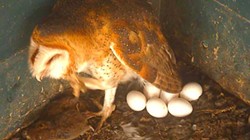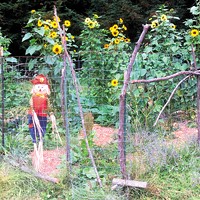Owls of the Bell Tower
Learning from the loss of Ferndale's feathered family
By Kimberly Wear [email protected] @kimberly_wear[
{
"name": "Top Stories Video Pair",
"insertPoint": "7",
"component": "17087298",
"parentWrapperClass": "fdn-ads-inline-content-block",
"requiredCountToDisplay": "1"
}
]
Paul Beatie still remembers that January night in 2017 when he first turned on the video feed from the camera he'd set up in the bell tower of a former Ferndale church to catch a glimpse of the barn owls that had made themselves at home inside.
So excited he couldn't sleep, Beatie waited for the owls to appear until one came into view, was gone then back — this time with a rat in tow. He couldn't have been happier.
"It was really exciting, like The Truman Show," says Beatie, the owner of The Ferndale Music Company and The Old Steeple, referring to the film about a boy who grows up not realizing his whole life is playing out on screen as part of a reality television show.
That's how Truman the owl received her name and, almost overnight, the breeding pair become something of an internet sensation — with Beatie even making an appearance on Good Morning Sacramento as their eggs began to hatch before a live audience.
Much like her namesake, hundreds tuned in over the last two years to watch Truman and her mate raise their broods via the so-called "Owl Cam," which also offers sweeping views of downtown Ferndale and the valley beyond.
But their story doesn't come with a happy ending. While five owlets lived long enough to fledge this year, the young birds suddenly began dying one after the other at the end of June, despite not having any visible signs of trauma.
Two died in quick succession within hours of being found on the sidewalk below the bell tower, while a third was discovered in the nest. One lived long enough for Beatie to take it to a wildlife care center, where he was told the bird's symptoms appeared to be consistent with poisoning.
Now, only Truman remains inside the tower. The rest, including her mate, have simply disappeared.
Looking for answers, Beatie turned to Lisa Owens Viani, co-founder and director of the Berkeley-based nonprofit Raptors Are The Solution, an advocacy group that lobbies against rodenticide use and works to educate the public about the important role raptors play in the environment, including pest control.
The two had met a few years before, introduced in a way by the owls themselves, which Viani had spotted swooping in and out of the steeple during one of her regular vacations at Ferndale's Gingerbread Mansion.
"I thought that was so cool," Viani recalls.
She introduced to herself to Beatie, who at the time had recently bought the 1902 building at Bluff and Berding streets, wanting to make sure he was aware of the birds and not using poisons, something he was already careful to avoid. After that, they stayed in touch.
"Just from time to time I would reach out and ask about the owls, Viani says.
After hearing the news about this year's fledglings, she helped arrange for two to be tested at a California Fish and Wildlife lab and the results surprised them.
While rodenticide was detected in one of the owls' liver, neither had ingested enough rat poison for that to be the cause of death. Nor were there any other underlying conditions or infections present, such as West Nile virus. Instead, the lab determined the birds had died of starvation.
Beatie says he was told similar conditions were increasingly being seen in barn owls across the state, likely due to the longstanding drought, but he can't help but wonder if there was something more at work, especially considering the ample expanse of open space surrounding the bucolic town.
"Here, it doesn't make sense because there's plenty of food," he says.
Instead, Beatie believes it "isn't a stretch" to say rodenticide likely played a role. "It's not what killed them but it definitely impacted their ability to live," he says.
The lethal impact of rodenticides on wildlife has been well documented.
Since 1994, the California Department of Fish and Wildlife has cataloged hundreds of poisoning cases related to anticoagulant rodent bait, which essentially blocks an animal's blood from clotting, causing it to die a painful death from internal hemorrhaging.
And according to a recent Fish and Wildlife report, "the indirect effects of anticoagulant rodenticides include starvation due to decreased prey availability, secondary poisoning, reduction in clotting mechanisms and hypothermia."
The agency notes that the true impact is "likely to be much greater than we know," but adds that signs found in monitoring a variety of species "confirm widespread exposure."
Those widespread exposures included a bobcat and her cub found languishing from mange on the University of California at Santa Cruz campus in 2014, their conditions later linked to high rodenticide levels, and more cases in recent months. Closer to home, a study published in January found rat poisons used at marijuana farms in the counties of Humboldt, Mendocino and Del Norte were posing a threat to the survival of the endangered northern spotted owl, while earlier research made similar connections to the deaths of fishers in the region.
In 2014, California banned the public sale of the so-called second-generation anticoagulants, which are meant to kill with a single dose but often spread beyond their intended targets when dying rodents become opportunistic prey for other animals. The products can, however, still be used legally by the pest control industry.
That is something Viani's group is working to change, helping to support state legislation that would ban certain rat poisons outright and, if passed, would make California the first state to do so.
But efforts by Assemblyman Richard Bloom to completely ban the use of anticoagulants have repeatedly stalled in the state capitol, where Viani says another push will begin next year in what she describes as a "David and Goliath" battle against a powerful industry with well-funded lobbyists.
Her nonprofit organization, which is under the umbrella of the Earth Island Institute, also filed a lawsuit against the state in June, asserting that California has failed to comply with the Environmental Quality Act by failing to consider all new science about the impacts of the poisons on non-target species.
The point, Viani says, is to "take a multiprong approach to attack this problem, just trying in multiple ways to get this horrible stuff out of the food web."
"It just doesn't make any sense and we're trying our very best to stop it," she says.
Viani spent years working with environmental organizations before being spurred to action against rodenticide use in 2011. Neighbors who knew she was a volunteer with the Golden Gate Raptor Observatory started bringing her Cooper's hawks they were finding dead or dying in their backyards.
When she had them tested, the results came back positive for rodenticide and Viani says she began her own grassroots campaign, going door-to-door to beg her neighbors not to use the poison.
That effort soon grew into Raptors Are The Solution, which now conducts statewide education campaigns about not just the dangers of rodenticide use but also the benefits that a healthy population of hawks, owls and other birds of prey can provide.
She notes that people also need to understand the sublethal effects of the poisons, which might not always outwardly kill but ultimately weaken an animal or have other impacts, pointing to studies that indicate young owls fed tainted prey can have shorter wingspans that impede their ability to fly or otherwise fail to thrive.
That, Viani believes, is what likely occurred in the case of the Ferndale owls.
It's possible the starvation correlates with the adult male's disappearance — which could itself be due to poisoning — because the owlets were still depending on help from their parents and Truman might not have been able to bring back enough prey for them all.
Or, perhaps, the rodenticide level found in at least one of the owls was enough to interfere with its ability to hunt. Regardless, Viani says, it seems likely there could be a connection.
"We like to say no poison is the solution," she says. "There is no 'good' poison out there. It's really not the way to go for so many reasons."
Viani notes that young owls already have a tough start in life, with only 30 percent surviving their first year. Low flyers in their quest for rodents, many are hit by cars — if they make it thought the notorious sibling rivalries of the nest, where the younger of the brood is often pitted against the older and stronger members in a bitter fight for food.
"To have rat position on top of all other challenges is just something we don't need to do to them," Viani says.
Viani describes a mouse poisoned by second-generation anticoagulants as a "little toxic time bomb," saying while one might not kill an owl, "it wouldn't take many, some of those poisons are so strong."
"We have these incredible animals in our midst that give free pest control, in addition to just being beautiful, and if we want to keep them, we've got to stop doing this," Viani says.
According to Matt Johnson, a Humboldt State University professor who is studying how effective barn owls are at pest control, a single family with four chicks will eat about 1,000 rodents during the breeding season, which can occur twice a year.
His attention is currently focused on the owl boxes many Napa vineyards have put up in an effort to lure in the stealthy hunters, mainly to target the scourge of gophers. As an added bonus, they are also popular with the tourists and some wineries have even taken to adding their images to wine labels.
Majestic with large faces and snowy white underbellies, Johnson says barn owls have an almost angelic quality to them. That is, unless you peak inside their nests (which anyone who spent much time on the "Owl Cam" can attest to).
"They are disgusting and they're snappy and they poop everywhere," Johnson says. "But then they take flight and it's another story."
Using owl boxes is a method that's been employed in the agricultural arena for several decades, Johnson says, but "no one has ever asked the question very rigorously: Do they really help or not?" While he's still working on an answer, he has found that the birds are hunting in the vineyards about one-third of the time.
"We still need to do a follow up study to find out if it's reducing the (rodent) population," he says. "So, 1,000, is that a lot or a little?"
So far, the vast majority of vintners have responded with a resounding yes. "They think it really helps," Johnson says.
He says a number of wineries are still using other methods of pest control, including trapping and in some cases rodenticides, so that is another facet his study still needs to tackle.
"We hope to keep doing this for a while," Johnson says. "We have a lot more questions."
But, he says, the end goal is to create a "win-win" scenario, where scientists will have the data needed "to make recommendations that help the farmers and, at the same time, be good for the owls."
Meanwhile, Beatie sees a learning opportunity from the deaths of this year's owls — the latest in a long line to occupy the historic bell tower — even if the exact story behind what happened is never known.
"I used to use d-CON growing up, that is sort of what we did, but we didn't know," he says. "The more people who know, hopefully, the less it will get used and the more owls will survive."
Editor's note: This story was updated from a previous version.
Kimberly Wear is the assistant editor at the Journal. Reach her at 442-1300, extension 323, or [email protected]. Follow her on Twitter @kimberly_wear.
Speaking of The Old Steeple
-

Music Tonight: Saturday, Sept. 30
Sep 30, 2023 -

Music Tonight: Wednesday, March 22
Mar 22, 2023 -

Music Tonight: Tuesday, Feb. 21
Feb 21, 2023 - More »
Comments
Showing 1-1 of 1
more from the author
-
Dust to Dust
The green burial movement looks to set down roots in Humboldt County
- Apr 11, 2024
-
Our Last Best Chance
- Apr 11, 2024
-
Judge Rules Arcata Can't Put Earth Flag on Top
- Apr 5, 2024
- More »
Latest in News
Readers also liked…
-
Through Mark Larson's Lens
A local photographer's favorite images of 2022 in Humboldt
- Jan 5, 2023
-
'To Celebrate Our Sovereignty'
Yurok Tribe to host gathering honoring 'ultimate river warrior' on the anniversary of the U.S. Supreme Court ruling that changed everything
- Jun 8, 2023


































